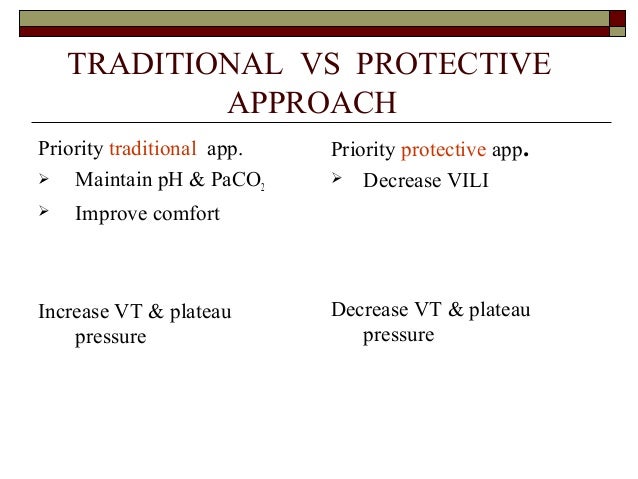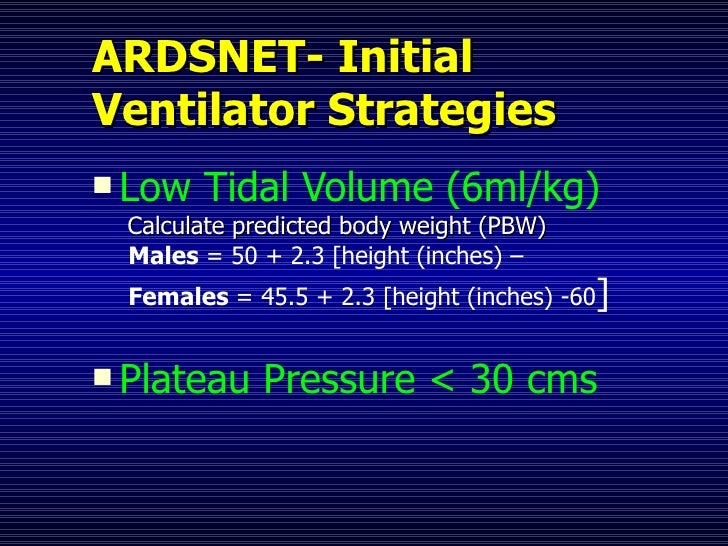

It can be combined with an open lung approach in moderate-severe ARDS (i.e.set a tidal volume of 6mL/kg based on predicted body weight (PBW) and target plateau pressures IT is also a reasonable default ventilation strategy in all mechanically ventilated patients.

Protective lung ventilation should be used for mechanically ventilated patients with ARDS and those with risk factors for developing ARDS.high-risk surgery (including cardiac surgery).RR =0.4 for a composite of major pulmonary and extrapulmonary complications occurring within the first 7 days after surgery for protective lung ventilationĪ number of studies support the protective lung ventilation approach in settings such as:.non-protective versus protective lung ventilation.decreased lung injury development (risk ratio, 0.33 95% CI, 0.23 to 0.47 I2, 0% NNT = 11).Serpa Neto et al (2012) performed a meta-analysis of 20 studies (n=2822) that showed patients receiving lower tidal volumes had: avoiding excessive plateau pressures may be as important as low tidal volumes.note that the tidal volume could be adjusted so long as the plateau pressure was This is described in detail in ARDSnet Ventilation Strategy.
#Ardsnet tidal volume chart tv#
critics have questioned the ethics of this studied, arguing that standard practice at the time was not TV 12 mL/kg for all comers and that this led to practice misalignment.perhaps more of a study of plateau pressures that tidal volumes per se, as Pplat max was strictly adhered to.terminated early after the fourth interim analysis.low TV group received high PEEP to maintain oxygenation (a co-intervention) - this led to the ALVEOLI study which found no mortality benefit for high PEEP levels.good baseline balance (except higher minute ventilation in low TV group).significant reduction in duration of MV (mean, 12☑1 vs.in hospital mortality (31.0 percent vs.outcomes in favour of low TV versus high TV ventilation:.n = 861 adult patients with ALI/ARDS: bilateral infiltrates, P/F ratio 36 hours of ventilation, The Acute Respiratory Distress Syndrome Network. Ventilation with lower tidal volumes as compared with traditional tidal volumes for acute lung injury and the acute respiratory distress syndrome. This led to the ARDSnet ARMA trial, the practice-defining study that established protective lung ventilation being the standard of careĪRDSNet.Following the Amato 1998 study, three other controlled ‘protective’ ventilation trials failed to find a benefit, purported to be due to study design issues.1998 - Amato et al publish as a small RCT suggests mortality benefit from low tidal volume ventilation.1996 - a large survey of intensivists’ ventilation practices for patients with ARDS showed most respondents reported using VTs >10 ml/ kg.1992 - Hickling introduces the concept of permissive hypercapnia.potential harms of high tidal volumes increasingly recognised in the 1970s and 1980s.early studies in ARDS patients described ventilation with a variety of VTs ranging from 10 to 24 mL/kg.for the next 50 years (!) anesthesiology textbooks continue to maintain that VT should be between 10–15 mL/kg for these benefits.showed that higher tidal volumes (VT) during anesthesia (18 patients undergoing laparotomy) resulted in less atelectasis, less acidosis, and improved oxygenation compared to lower VT.growing evidence of benefit in patients without ARDS, as all mechanically ventilated patients are at risk of VALI.clear evidence for benefit in ARDS in animals and humans.hypercapnia may also have directly beneficial effects in ARDS.biotrauma (release of inflammatory mediators).barotrauma (alveolar rupture and pneumothorax).volutrauma (hyperinflation and shearing injury).low tidal volume ventilation reduces ventilator-associated lung injury (VALI).Note: PBW in men is calculated as 50 (45 in women) + 0.91 (Height cm −152.4).

#Ardsnet tidal volume chart trial#


 0 kommentar(er)
0 kommentar(er)
